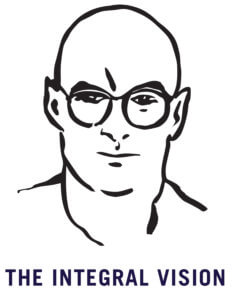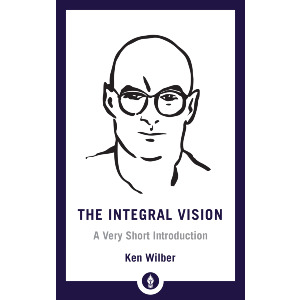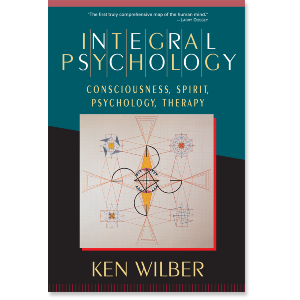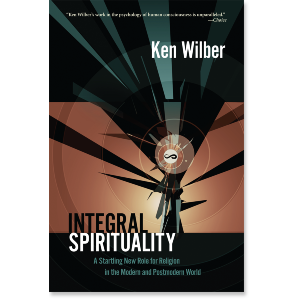What Type: Boy or Girl?
The next component of the “Comprehensive Map of the Territory of You” is easy: each of the previous components has a masculine and feminine type.
Types simply refers to items that can be present at virtually any stage or state. One common typology, for example, is the Myers-Briggs (whose main types are feeling, thinking, sensing, and intuiting). You can be any of those types at virtually any stage of development. These kinds of “horizontal typologies” can be very useful, especially when combined with levels, lines, and states. To show what is involved, we can use “masculine” and “feminine” as one example of types.
Carol Gilligan, in her enormously influential book In a Different Voice, pointed out that both men and women tend to develop through 3 or 4 major levels or stages of moral development. Pointing to a great deal of research evidence, Gilligan noted that these 3 or 4 moral stages can be called preconventional, conventional, postconventional, and integrated. These are actually quite similar to the 3 simple developmental stages we are using, this time applied to moral intelligence.
Gilligan found that stage 1 is a morality centered entirely on “me” (hence this preconventional stage or level is also called egocentric). Stage-2 moral development is centered on “us,” so that my identity has expanded from just me to include other human beings of my group (hence this conventional stage is often called ethnocentric, traditional, or conformist). With stage-3 moral development, my identity expands once again, this time from “us” to “all of us,” or all human beings (or even all sentient beings)—and hence this stage is often called worldcentric. I now have care and compassion, not just for me (egocentric), and not just for my family, my tribe, or my nation (ethnocentric), but for all of humanity, for all men and women everywhere, regardless of race, color, sex, or creed (worldcentric). And if I develop even further, at stage-4 moral development, which Gilligan calls integrated, then . . .
Well, before we look at the important conclusion of Gilligan’s work, let’s first note her major contribution. Gilligan strongly agreed that women, like men, develop through those 3 or 4 major hierarchical stages of growth. Gilligan herself correctly refers to these stages as hierarchical because each stage has a higher capacity for care and compassion. But she said that women progress through those stages using a different type of logic—they develop “in a different voice.”
Male logic, or a man’s voice, tends to be based on terms of autonomy, justice, and rights; whereas women’s logic or voice tends to be based on terms of relationship, care, and responsibility. Men tend toward agency; women tend toward communion. Men follow rules; women follow connections. Men look; women touch. Men tend toward individualism, women toward relationship. One of Gilligan’s favorite stories: A little boy and girl are playing. The boy says, “Let’s play pirates!” The girl says, “Let’s play like we live next door to each other.” Boy: “No, I want to play pirates!” “Okay, you play the pirate who lives next door.”
Little boys don’t like girls around when they are playing games like baseball, because the two voices clash badly, and often hilariously. Some boys are playing baseball, a kid takes his third strike and is out, so he starts to cry. The other boys stand unmoved until the kid stops crying; after all, a rule is a rule, and the rule is: three strikes and you’re out. Gilligan points out that if a girl is around, she will usually say, “Ah, come on, give him another try!” The girl sees him crying and wants to help, wants to connect, wants to heal. This, however, drives the boys nuts, who are doing this game as an initiation into the world of rules and male logic. Gilligan says that the boys will hurt feelings in order to save the rules; the girls will break the rules in order to save the feelings.
In a different voice. Both the girls and boys will develop through the 3 or 4 developmental stages of moral growth (egocentric to ethnocentric to world centric to integrated), but they will do so in a different voice, using a different logic. Gilligan specifically calls these hierarchical stages in women selfish (which is egocentric), care (which is ethnocentric), universal care (which is worldcentric), and integrated. Again, why did Gilligan (who has been badly misunderstood on this topic) say that these stages are hierarchical? Because each stage has a higher capacity for care and compassion. (Not all hierarchies are bad, and this is a good example of why.)
So, integrated or stage 4—what is that? At the 4th and highest wave of moral development, according to Gilligan, the masculine and feminine voices in each of us tend to become integrated. This does not mean that a person at this stage starts to lose the distinctions between masculine and feminine, and hence become a kind of bland, androgynous, asexual being. In fact, masculine and feminine dimensions might become more intensified. But it does mean the individuals start to befriend both the masculine and feminine modes in themselves, even if they characteristically act predominantly from one or the other.
Have you ever seen a caduceus (the symbol of the medical profession)? It’s a staff with two serpents crisscrossing it, and wings at the top. The staff itself represents the central spinal column; where the serpents cross the staff represents the individual chakras moving up the spine from the lowest to the highest; and the two serpents themselves represent solar and lunar (or masculine and feminine) energies at each of the chakras.
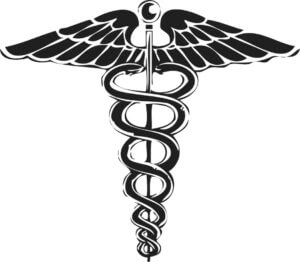
That’s the crucial point. The 7 chakras, which are simply a more complex version of the 3 simple levels or stages, represent 7 levels of consciousness and energy available to all human beings. (The first three chakras—food, sex, and power—are roughly stage 1; chakras 4 and 5—relational heart and communication—are basically stage 2; and chakras 6 and 7—psychic and spiritual—are the epitome of stage 3). The important point here is that, according to the traditions, each of those 7 levels has a masculine and feminine mode (aspect, type, or “voice”). Neither masculine nor feminine is higher or better; they are two equivalent types at each of the levels of consciousness.
This means, for example, that with chakra 3 (the egocentric-power chakra), there is a masculine and feminine version of the same chakra: at that chakra-level, males tend toward power exercised autonomously (“My way or the highway!”), women tend toward power exercised communally or socially (“Do it this way or I won’t talk to you”). And so on with the other major chakras, each of them having a solar and lunar, or masculine and feminine, dimension. Neither is more fundamental; neither can be ignored.
At the 7th chakra, however, notice that the masculine and feminine serpents both disappear into their ground or source. Masculine and feminine meet and unite at the crown—they literally become one. And that is what Gilligan found with her stage-4 moral development: the two voices in each person become integrated, so that there is a paradoxical union of autonomy and relationship, rights and responsibilities, agency and communion, wisdom and compassion, justice and mercy, masculine and feminine.
The important point is that whenever you use IOS, you are automatically checking any situation—in yourself, in others, in an organization, in a culture—and making sure that you include both the masculine and feminine types so as to be as comprehensive and inclusive as possible. If you believe that there are no major differences between masculine and feminine—or if you are suspicious of such differences—then that is fine, too, and you can treat them the same if you want. We are simply saying that, in either case, make sure you touch base with both the masculine and feminine, however you view them.
But more than that, there are numerous other “horizontal typologies” that can be very helpful when part of a comprehensive IOS (Myers-Briggs, enneagram, etc.), and the Integral Approach draws on any or all of those typologies as appropriate. “Types” are as important as quadrants, levels, lines, and states.
Masculine and feminine meet and unite at the crown—they literally become one.
Sick Boy, Sick Girl
There’s an interesting thing about types. You can have healthy and unhealthy versions of them. To say that somebody is caught in an unhealthy type is not a way to judge them but a way to understand and communicate more clearly and effectively with them.
For example, if each stage of development has a masculine and feminine dimension, each of those can be healthy or unhealthy, which we sometimes call “sick boy, sick girl.” This is simply another kind of horizontal typing, but one that can be extremely useful.
If the healthy masculine principle tends toward autonomy, strength, independence, and freedom, when that principle becomes unhealthy or pathological, all of those positive virtues either over- or underfire. There is not just autonomy, but alienation; not just strength, but domination; not just independence, but morbid fear of relationship and commitment; not just a drive toward freedom, but a drive to destroy. The unhealthy masculine principle does not transcend in freedom, but dominates in fear.
If the healthy feminine principle tends toward flowing, relationship, care, and compassion, the unhealthy feminine flounders in each of those. Instead of being in relationship, she becomes lost in relationship. Instead of a healthy self in communion with others, she loses her self altogether and is dominated by the relationships she is in. Not a connection, but a fusion; not a flow state, but a panic state; not a communion, but a meltdown. The unhealthy feminine principle does not find fullness in connection, but chaos in fusion.
Using IOS, you will find ways to identify both the healthy and unhealthy masculine and feminine dimensions operating in yourself and in others. But the important point about this section is simple: various typologies have their usefulness in helping us to understand and communicate with others. And with any typology, there are healthy and unhealthy versions of a type. Pointing to an unhealthy type is not a way to judge people, but a way to understand and communicate with them more clearly and effectively.
There’s Even Room for Many Bodies
Let’s return now to states of consciousness in order to make a final point before bringing this all together in an integral conclusion.
States of consciousness do not hover in the air, dangling and disembodied. On the contrary, every mind has its body. For every state of consciousness, there is a felt energetic component, an embodied feeling, a concrete vehicle that provides the actual support for any state of awareness.
Let’s use a simple example from the wisdom traditions. Because each of us has the 3 great states of consciousness—waking, dreaming, and formless sleep—the wisdom traditions maintain that each of us likewise has 3 bodies, which are often called the gross body, the subtle body, and the causal body.
I have 3 bodies? Are you kidding me? Isn’t one body enough? But keep in mind a few things. For the wisdom traditions, a “body” simply means a mode of experience or energetic feeling. So there is coarse or gross experience, subtle or refined experience, and very subtle or causal experience. These are what philosophers would call “phenomenological realities,” or realities as they present themselves to our immediate awareness. Right now, you have access to a gross body and its gross energy, a subtle body and its subtle energy, and a causal body and its causal energy.
What’s an example of these 3 bodies? Notice that, right now, you are in a waking state of awareness; as such, you are aware of your gross body—the physical, material, sensorimotor body. But when you dream at night, there is no gross physical body; it seems to have vanished. You are aware in the dream state, yet you don’t have a gross body of dense matter but a subtle body of light, energy, emotional feelings, fluid and flowing images. In the dream state, the mind and soul are set free to create as they please, to imagine vast worlds not tied to gross sensory realities but reaching out, almost magically, to touch other souls, other people and far-off places, wild and radiant images cascading to the rhythm of the heart’s desire. So what kind of body do you have in the dream? Well, a subtle body of feelings, images, even light. That’s what you feel like in the dream. And dreams are not “just illusion.” When somebody like Martin Luther King, Jr., says, “I have a dream,” that is a good example of tapping into the great potential of visionary dreaming, where the subtle body and mind are set free to soar to their highest possibilities.
As you pass from the dream state with its subtle body into the deep-sleep or formless state, even thoughts and images drop away, and there is only a vast emptiness, a formless expanse beyond any individual “I” or ego or self. The great wisdom traditions maintain that in this state—which might seem like merely a blank or nothingness—we are actually plunged into a vast formless realm, a great Emptiness or Ground of Being, an expanse of consciousness that seems almost infinite. Along with this almost infinite expanse of consciousness there is an almost infinite body or energy—the causal body, the body of the finest, most subtle experience possible, a great formlessness out of which creative possibilities can arise.
When somebody like Martin Luther King, Jr., says, “I have a dream,” that is a good example of tapping into the great potential of visionary dreaming, where the subtle body and mind are set free to soar to their highest possibilities.
Of course, many people do not experience that deep state in such a full fashion. But again, the traditions are unanimous that this formless state and its causal body can be entered in full awareness, whereupon they, too, yield their extraordinary potentials for growth and awareness.
The point, once again, is simply that whenever IOS is being utilized, it reminds us to check in with our waking-state realities, our subtle-state dreams and visions and innovative ideas, as well as our own open, formless ground of possibilities that is the source of so much creativity. The important point about the Integral Approach is that we want to touch base with as many potentials as possible so as to miss nothing in terms of possible solutions, growth, and transformation.
Consciousness and Complexity
Perhaps 3 bodies are just too “far out”? Well, remember that these are phenomenological realities, or experiential realities, but there is a simpler, less far-out way to look at them, this time grounded in hard-headed science. It is this: every level of interior consciousness is accompanied by a level of exterior physical complexity. The greater the consciousness, the more complex the system housing it.
For example, in living organisms, the reptilian brain stem is accompanied by a rudimentary interior consciousness of basic drives such as food and hunger, physiological sensations, and sensorimotor actions (everything that we earlier called “gross,” centered on the “me”). By the time we get to the more complex mammalian limbic system, basic sensations have expanded and evolved to include quite sophisticated feelings, desires, emotional-sexual impulses, and needs (hence the beginning of what we called subtle experience or the subtle body, which can expand from “me” to “us”). As evolution proceeds to even more complex physical structures, such as the triune brain with its neocortex, consciousness once again expands to a worldcentric awareness of “all of us” (and thus even begins to tap into what we called the causal body).
That is a very simple example of the fact that increasing interior consciousness is accompanied by increasing exterior complexity of the systems housing it. When using IOS, we often look at both the interior levels of consciousness and the corresponding exterior levels of physical complexity, since including both of them results in a much more balanced and inclusive approach.
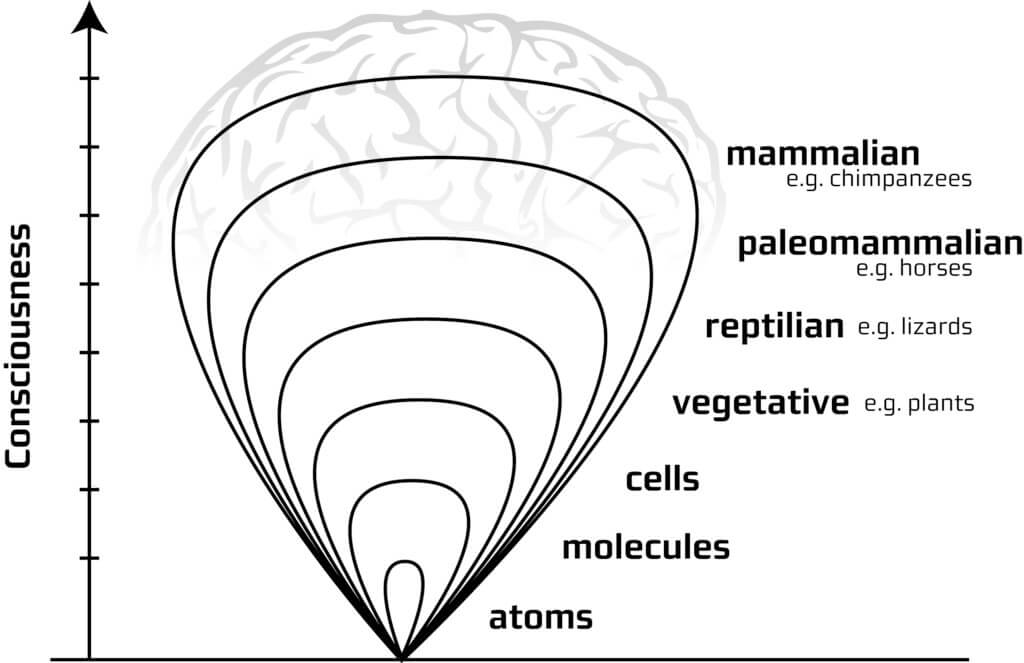
Related Books
$12.95 - Paperback
$16.95 - Paperback
$27.95 - Paperback
$34.95 - Paperback



